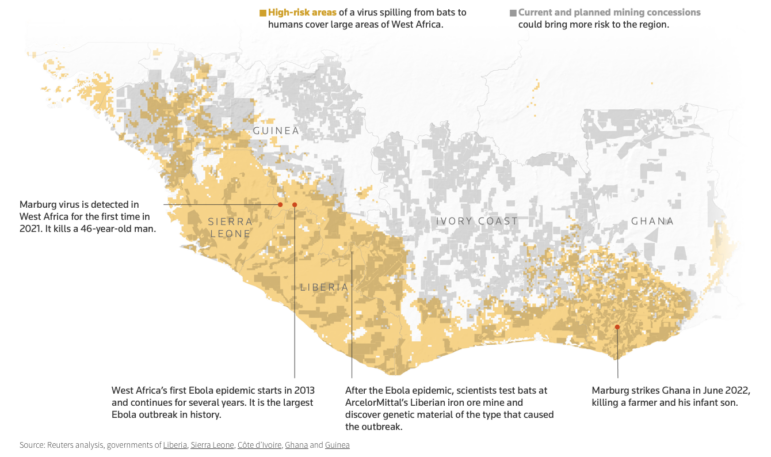
Reuters’ five-part data investigative series looked into areas where bats and humans increasingly interact — like West Africa — to offer a preview of where the next global pandemic may come from. Image: Screenshot, Reuters
The next global pandemic could come — yet again — from bats. This is the conclusion that Reuters presents in a five-part special investigation on the impacts of the destruction of the natural habitats of these animals and the consequent interactions with humans. This week, our look at the Top 10 in Data Journalism also highlights how China is dominating the battery market for electric cars, the differences between intention and reality in migration flows, and the “holes” in assistance offered by the Brazilian public health system.
Bats and the Next Pandemic
Bats are an important part of the world’s ecosystem: they help pollinate flowers and spread seeds, as well as keep control of insect populations. But they are also carriers of thousands of viruses, which despite being innocuous to the animals themselves, can end up harming the humans who are increasingly invading their habitats. In a five-part, first-of-its-kind project, Reuters spoke to scientists, read academic research, consulted disease-outbreak and environmental data, and traveled to places with high concentrations of bats to reveal the close proximity between humans and these animals and how this relationship could lead to yet another global health emergency. Reuters also focused on where potential outbreaks are most likely: Laos, China, India, Brazil, and West Africa – and why.
THREAD: I want to tell you a little background of our new series, which dates back to the summer of 2020 when COVID was raging around the world. My colleague Deb Nelson and I started talking about the next one and how to stop it. https://t.co/xNK2ItNshT
— Ryan McNeill (@McNeill_Tweets) May 16, 2023
China’s Electric Battery Dominance
Can the World Make an Electric Car Battery Without China? The answer to that question, according to The New York Times, is no. The race to produce electric vehicles has barely begun and China is already way ahead of everyone else, it concluded: “mining rare minerals, training engineers, and building huge factories — that the rest of the world may take decades to catch up.” In this piece, the newspaper visualizes how the Asian country controls each stage of lithium-ion battery production, with predominance over the necessary raw materials, and explains the advantages the country enjoys to produce cheaper components, such as lower labor costs and loose regulation.
Love to see how organizations come up with new ways to tell visually compelling stories.
This is a cute alternative by @nytimes. Normal stacked bars would've done the job but these little piles of elements are so CUTE!https://t.co/8Lh3LGH8Xi pic.twitter.com/VWcVXQC3Y1
— Mafe Callejón (@MafeCafe) May 16, 2023
Sustainable Fishing
The global fishing industry supports more than half a billion people worldwide, according to the Financial Times, so it’s important to think about the long-term sustainability of fisheries, not just for the preservation of the world’s ecosystems, but also as a source of income and food. On a global average, 15% of the protein that a person consumes comes from fish, a figure that reaches as high as 50% in some Asian countries. Since 1950, the amount of fish a person consumes has doubled, while the global population has more than tripled, which could represent a threat to our rivers and oceans. What are some possible solutions? In addition to aquaculture, or farmed fish, international cooperation and multilateral governance are important to ensure that fish stocks remain viable.
Simple, informative and impactful. Have a read! https://t.co/Z0HqU0t5rN
— Sophie Loca (@loca_sophie) May 22, 2023
Brazil’s Healthcare ‘Holes’
In Brazil, at least one out of every eight people live in municipalities with little or no medical infrastructure, which means that residents need to go to other cities in search of tests or treatments. In this piece, the Brazilian news portal G1 points out these “holes” in medical care in the country’s public health system. In 2021 alone, there were four million internal displacements, with about a third of medical care in the country provided to patients outside their city of origin. The distances covered are also large: on average, 72 kilometers (45 miles) to receive medical care and 150 kilometers (93 miles) to undergo surgeries and other procedures. For this report, G1 used data taken from a National Treasury survey based on information from the Ministry of Health and the Brazilian Institute of Geography and Statistics.
Hoje é dia de destacar esse texto da @marinapagno .
A matéria se baseia em grande parte em nosso trabalho no @TesouroNacional.
Marina é criteriosa no relato dos dados do nosso painel, nas entrevistas e na organização do texto. Um primor de jornalismo. https://t.co/XEBNEf1s65— Fernando Barbalho (@barbalhofernand) May 23, 2023
Migration Intention vs. Reality
When the US Army left Afghanistan in 2021, it triggered a mass migration event. But where did all these people want to go — and where did they actually end up? Data visualization designer Mohamad Waked looked into this disparity, comparing Google search data with actual migration figures. In an interactive piece exploring the differences, he found US, Germany, Canada, and Australia topped the online search results for Afghans, but that Iran and Pakistan ultimately received roughly 90% of Afghan migrants, while Saudi Arabia and Turkey received almost all the rest. Readers can explore data on trends between 2005 and 2020 and research their own country.
🎉 NEW #DATAVIZ PROJECT!! 🎉
A visual exploration supported by @GoogleTrends, @AlbertoCairo & @smfrogers"Migration between Search & Reality"
I was curious to EXPLORE the GAP between REALITY of world's #migrants and their SEARCH interest 🧐>> https://t.co/AahBd7h1pq pic.twitter.com/OWNpZXidDZ
— Mohamad Waked (@mohamad_waked) May 16, 2023
Italy Underwater
In the aftermath of recent rains and flooding in the Italian region of Emilia-Romagna, which left 14 dead, tens of thousands displaced, and caused billions of euros of damage, Il Post presented a simple but important piece with data from the Italian Institute for Environmental Protection and Research (ISPRA). On the map, readers can see how much of Italy is exposed to hydrogeological risk linked to landslides and floods, with some of the greatest vulnerability in Emilia-Romagna. In general, Italy faces greater flooding risks because the space to contain water runoff is limited. And in recent decades, this phenomenon has gotten worse thanks to the expansion of urban centers and industrial areas. Il Post also mentioned initiatives that can neutralize the effects of soil erosion, such as replanting in river areas and the construction of ditches and small lakes in the countryside, which help to collect water.
Le aree a rischio alluvione in Italia https://t.co/32kH2DdNEt via @ilpost #ddj @ISPRA_Press
— Isaia Invernizzi (@EasyInve) May 21, 2023
The Help Line That Didn’t
A telephone help line for those on the minimum vital income is a benefit provided by the Spanish government aimed at mitigating poverty and the social exclusion of people who live alone or lack basic economic resources in Spain. But increasingly, no one would answer when it was called. To test its lack of response, the Civio team created a robot that called the number every 30 minutes during working hours. Only after 18 days — 151 calls in total — did someone finally pick up. After the report came out, the country’s Ministry of Inclusion, Social Security, and Migration said it would hire another 195 people to deal with the intense flow of calls received by the service.
🚨 Nuevo en @civio:
Volvemos a uno de los temas que más nos preocupan: el difícil acceso de las personas vulnerables a las ayudas.Ponemos el ojo en el ☎️ de ayuda del #IMV:
18 días llamando cada media hora para que una persona -humana- coja el aparato.https://t.co/ADw0HI039v pic.twitter.com/AEBZWcUwF1— Carmen Torrecillas (@carmen_TM_) May 18, 2023
Analyzing Greek Politicians’ Speeches
Ahead of that country’s recent elections, iMEdD used “a collaboration between humans and artificial intelligence” to analyze the pre-election campaign speeches of Greece’s six main political leaders. In this interactive piece, iMEdD revealed the different themes that dominate their speeches, which ones invoked greater levels of polarization and populism, and what percentage of each politician’s speech was dedicated to the the policies of their own party versus criticism of their opponents.
1/8
🗳️🤖#Elections2023 Analyzing the pre-election speeches of the leaders (@kmitsotakis, @atsipras, @androulakisnick, Dimitris Koutsoumpas, Kyriakos Velopoulos, @yanisvaroufakis) of the 6 parliamentary parties using #AI.
Find the analyses here: https://t.co/CnlZnYzfAe
— iMEdD_Lab (@iMEdDLab) May 4, 2023
Media War Allies?
Reporters from the exiled Russian-language TV channel Current Time and the Hungarian service Radio Liberty analyzed more than 15,000 Russian and Hungarian pro-government media publications to learn what narratives both countries are using to discuss the invasion of Ukraine and the notion of a Europe divided about the war. Reality and the propaganda didn’t really align, explain the journalists. Despite Hungary having tried several times to block EU sanctions against Russia or having issued statements that denounced the actions of Ukraine, the country ended up voting in favor of all seven UN General Assembly resolutions condemning Russian aggression and supporting Ukrainian territorial integrity, repatriation, and other war-related issues.
Вот что мы обнаружили: https://t.co/sL2764NoNO
— Настоящее Время (@CurrentTimeTv) May 15, 2023
How Many Leaks Are You In?
If you’ve ever wondered how many data breaches your personal information has appeared in, this ABC News tool is for you. By entering your email, you can see how many leaks you’re included in, by which companies, and what types of your personal data are available online. The database used is the same as for the website Have I Been Pwned?, a service that tracks stolen data across the internet by Australian online security expert Troy Hunt. Searching through the leaks is a good way to see what the team behind the tool calls the “mosaic effect”: by picking up pieces of your personal information across different leaks, criminals can piece together a detailed picture of your identity and use this data in the future in scams and fraud. The end result can be quite alarming.
Over the last few months, I’ve been working on a little project with the ABC here in Australia to help people visualise their exposure in data breaches. This has just gone live today and I reckon they’ve done an amazing job, check it out: https://t.co/K0QXip1Je2
— Troy Hunt (@troyhunt) May 17, 2023
 Ana Beatriz Assam is GIJN’s Portuguese editor and a Brazilian freelance journalist. She worked for the newspaper O Estado de São Paulo as a freelancer, mainly covering stories with data journalism. She has also worked with the Brazilian Association of Investigative Journalism (Abraji) moderating journalism courses.
Ana Beatriz Assam is GIJN’s Portuguese editor and a Brazilian freelance journalist. She worked for the newspaper O Estado de São Paulo as a freelancer, mainly covering stories with data journalism. She has also worked with the Brazilian Association of Investigative Journalism (Abraji) moderating journalism courses.
